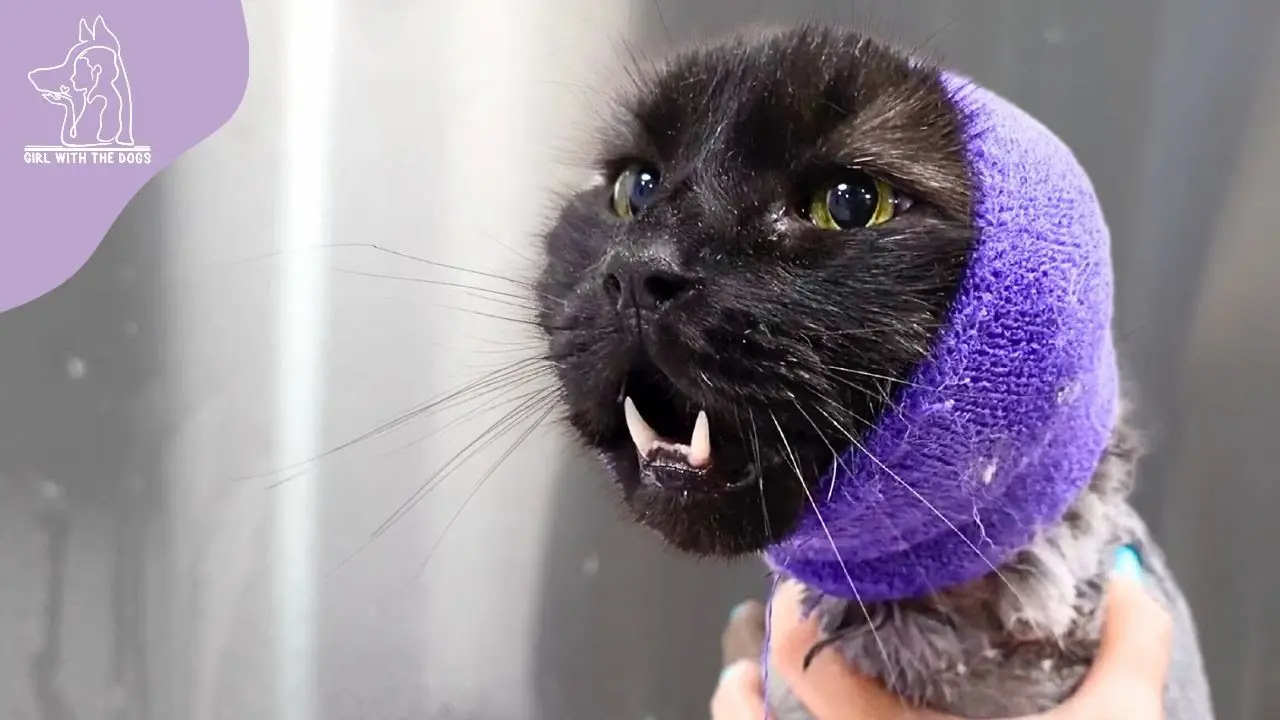Revealed: The Secret Technique to Make Your Cat Beg for Bath Time
Ever feel like you’ve just survived a horror movie after giving your
You’re not alone.
Cats and water don’t usually mix well, and trying to bathe them can often result in chaos for both you and your
Preparing Your Cat for a Bath
Getting your
Gradual Introduction to Water
Cats generally dislike water, so introducing them slowly is key.
Start by letting your
For instance, you might place a shallow dish of water nearby and let them sniff or play with it.
Gradually work up to wetting their paws slightly.
In my experience, patience pays off here.
Don’t rush this process; some cats take days or even weeks to get comfortable with each step.
Always ensure that you’re calm and positive during these interactions because cats can pick up on your stress.
Creating a Calming Environment
The bathing environment plays a significant role in how well your
Choose a quiet bathroom where you won’t be disturbed by noises or sudden movements.
Close doors and windows to minimize distractions and prevent escape attempts.
Before the bath, gather all supplies – shampoo, towels, a cup for rinsing – within reach.
You don’t want to scramble for items midway through the bath while trying to keep hold of a slippery
Using a non-slip mat in the sink or tub helps provide stability for your catfriend.
Also, I’ve found that speaking softly and soothingly throughout the bath can make a big difference.
Some people even play soft music to create an even more calming atmosphere.
Taking these steps doesn’t guarantee your
Essential Supplies for Bathing Your Cat
Alright, let’s talk gear.
You might be wondering what exactly you need to make bath time as smooth as possible for your
Trust me, having the right supplies on hand makes a world of difference.
Choosing the Right Shampoo
First things first: shampoo. It’s essential to pick one specifically formulated for cats.
Using shampoos meant for humans or even dogs can cause skin irritations due to their different pH levels and ingredients.
One solid option is Burt’s Bees for Pets
It’s natural and gentle, which is a big win in my book.
If you’re dealing with a white
Other Necessary Tools
But don’t stop at just the shampoo—there’s more you’ll need:
- Brushes and Combs: Before getting your
cat wet, give them a good brush. A goodcat brush works wonders for removing loose fur and preventing tangles that can worsen when wet. For sensitive areas, use softer options like rubber brushes. - Nail Clippers and Scissors: Trimming nails beforehand helps prevent scratches during bath time. I recommend using something like the Mr. Pen-
Cat Nail Clipper, which is efficient and easy to handle. - Pitcher or Spray Nozzle: If your sink or tub lacks a spray nozzle, grab a pitcher to help with rinsing off all that shampoo thoroughly.
- Soft Cloth: Use this to clean your
cat ‘s face gently—remember to avoid getting water in their ears and eyes. - Cotton Balls: Clean the outside of your
cat ‘s ears carefully using cotton balls; never stick anything inside their ears as it could cause harm. - Rubber Gloves: Wearing these isn’t foolproof against scratches but provides some protection.
- Towel: Have a large towel ready to wrap up your kitty post-bath.
Setting everything up ahead of time within arm’s reach minimizes stress for you both—and trust me, that’s crucial when bathing a
So there you have it—the essentials lined up neatly.
Each item plays its role in making this less of an ordeal and more of an oddly satisfying task shared between you two.
Step-by-Step Guide to Bathing Your Cat
Bathing a
Here’s a detailed guide based on my years of experience as a vet.
Calming Your Cat Before the Bath
Before even starting the bath, making sure your
Start by letting your
Maybe just place them in the tub or sink for a bit with some treats around.
Do this several times over a few days if possible. Slowly introduce water sounds by turning on the faucet while they’re nearby but not in it yet.
Another tip: use pheromone sprays or diffusers designed specifically for cats to create a more relaxed environment.
And don’t forget to give them lots of praise and maybe their favorite toy before starting.
The Bathing Process
With everything ready, follow these steps:
- Prepare Everything in Advance: Ensure you’ve got all supplies within arm’s reach—cat shampoo (mild and pH-balanced), towel, brush, non-slip mat, pitcher or spray nozzle, soft cloth for wiping their face, and cotton balls for cleaning ears.
- Brush Your
Cat Before Bathing: This helps remove tangles and mats, making bathing easier on both of you. - Add
Cat to Water: Fill the sink or tub with just a few inches of lukewarm water—enough to touch their belly when standing up. Gently place yourcat inside while talking soothingly. - Wet Your
Cat Down: Avoid getting water above their neck; use a damp towel for their face if needed. Support your kitty with one hand under their tummy and wash with the other hand. - Lather and Rinse: Apply shampoo and lather gently but thoroughly avoiding sensitive areas like eyes and ears. Rinse well to avoid soap residue irritating their skin.
- Clean the Face: Use a soft cloth dampened with water to wipe off any dirt from your
cat ‘s whiskered face carefully.
Drying Your Cat After Bath
Once out of the bath, drying them quickly is key:
- Wrap in Towel: Immediately wrap your
cat in a large, absorbent towel to soak up excess water. - Use Additional Towels: If necessary, switch to another dry towel after the first gets soaked through.
- Gentle Patting: Pat down rather than rubbing vigorously which might stress them out more.
- Warm Environment: Keep them in a warm room until they’re completely dry; avoid drafts that could make them chilly.
If tolerated by your catfriend try using a blow dryer on its lowest setting at least 12 inches away – some cats don’t mind it if introduced gradually!
Tips to Make Bath Time Enjoyable
Bathing a
Here are some tips I’ve gathered over the years that can help make bath time a more pleasant experience for both you and your
Using Treats and Praise
Positive reinforcement goes a long way when it comes to getting your
I often use treats and praise to create a positive association with the whole process.
- Positive Reinforcement: Offering treats and praise during the bath helps your
cat associate this experience with something good. For example, give them their favorite treat right after they get wet or when they stay calm. - Gradual Introduction: Gradually introduce your
cat to the idea of bathing by taking small steps. Start by feeding them treats in the bathroom, then move on to placing them in an empty tub, and finally add water gradually. If you take it slow, they’ll be less likely to panic. - Reward Calm Behavior: Always reward calm behavior with treats and praise during and after the bath. This reinforces that being calm leads to positive outcomes.
Maintaining a Warm Temperature
Cats are like us in many ways; they prefer comfort. Keeping everything warm makes a big difference.
- Warm Water: Use warm water—not hot—because cats feel more comfortable at a cozy temperature. I’ve found that lukewarm works best.
- Warm Towels: After the bath, wrap your
cat in warm towels to dry them off gently. This not only dries them faster but also makes them feel secure and comfortable.
Additional Tips
Preparation is key to making bath time as smooth as possible.
- Prepare the Environment: Set up a non-slip surface in the sink or tub so your
cat doesn’t slip around, which can cause stress or injury. Use washcloths or cotton balls for cleaning delicate areas like their face and ears. - Calm Atmosphere: Keep the bathing area quiet and peaceful because loud noises can startle your
cat , making them more anxious about baths.
Troubleshooting Common Bath Time Issues
Bath time with cats can be tricky, but there are ways to make it smoother.
Let’s jump into some common issues and how to handle them.
Gradual Exposure
Gradually introducing your
Start by letting your
This helps them get used to the sounds and environment without the stress of a full bath.
For instance, my
Over time, she became more comfortable simply being around the bath setup.
Positive Reinforcement
Rewarding calm behavior with treats and praise can work wonders.
When Zoe stays calm during her bath, I give her her favorite treat afterward.
This positive association makes her less anxious about future baths. It’s important not to rush this process; patience truly pays off.
Choose the Right Products
Using gentle, pH-balanced shampoos specifically designed for cats minimizes irritation and discomfort.
Avoid using human shampoos as they often contain fragrances or chemicals that can harm your
I once made this mistake with an old product from my shower, and Zoe ended up very uncomfortable with irritated skin.
Maintain a Comfortable Temperature
Cats prefer lukewarm water when bathing.
Ensuring that the water is neither too hot nor too cold keeps them more relaxed during bath time. You wouldn’t want to step into an icy shower or a boiling bath either, right?
Minimize Restraint
Allowing your
During Zoe’s baths, I gently hold her but don’t confine her entirely; this makes her feel safer and less threatened.
Handling Aggression and Fear
Cats might show aggression or fear during baths due to past negative experiences or sheer dislike for water. If your
Use calming aids like
In extreme cases, consulting a vet for anti-anxiety treatments could be beneficial.
Once Zoe bit me pretty hard because she was terrified of slipping in the tub! So now, I place a non-slip mat at the bottom which provides better footing and reassurance.
What to Do If Your Cat Escapes
If your
Instead, let them settle down first before attempting another go at bathtime—perhaps break it up over two sessions if needed.
For example: One day, halfway through rinsing off soap from Zoe’s fur coat she bolted out of my grasp making puddles across our living room carpet!
After drying everything up calmly within ten minutes—I managed finishing what was left unstressed—by resuming where we last paused together again patiently next round.
Alternative Methods for Keeping Your Cat Clean
Bathing your
There are alternative ways to keep them clean and happy without the mess.
Waterless Shampoos and Wipes
Waterless shampoos are a lifesaver if your catfriend absolutely detests getting wet.
These products are easy to use and, most importantly, get the job done without all the splashing around.
Just apply the shampoo to your
It’s that simple!
Pet wipes work wonders too.
They’re perfect for spot cleaning or giving a light all-over wipe-down without drenching your
Look for unscented, hypoallergenic options that are safe for cats.
Once, I bought some citrus-scented wipes by mistake—big no-no! Cats can’t stand citrus smells, so be careful when picking out these products.
Professional Grooming Options
Sometimes it’s best to call in the pros.
If bathing your
Groomers have experience dealing with fussy felines and know how to keep things calm and stress-free.
A groomer can handle everything from basic baths to specialized treatments like de-matting or flea baths.
Plus, they often offer additional services like nail trimming and ear cleaning—consider it a spa day for your
Conclusion
Getting your
It’s all about finding that balance between keeping your catclean and ensuring they feel safe and comfortable.
Don’t forget there are alternatives like waterless shampoos and professional groomers if bathing at home isn’t working out.
Eventually making bath time a positive experience will not only benefit your






